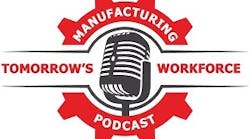Amanda Del Buono is joined by Neil Ridley, Georgetown University, Center on Education and the Workforce, state initiative director, to discuss the center's recent "The Way We Were" report, which analyzes the industry from the 1940s through today and how the workforce has been impacted.
Read the report here: http://bit.ly/2lYpVNk
Transcript
Amanda Del Buono: Hello and welcome back to Manufacturing Tomorrow’s Workforce, I’m Amanda Del Buono. Today, I’m joined by Neil Ridley state initiative director of Georgetown University’s Center on Education and Workforce. In our interview, Neil shares some great insights to expand on a new report the university released titled “The Way We Were.” The report provides a fascinating overview of the changes in the U.S. manufacturing industry from its hayday in the 1940s through 2016, and most notably, how the manufacturing industry has moved throughout the country.
Here’s the interview.
So, I’m being joined today by Neil Ridley of Georgetown University’s Center on Education and Workforce state initiative director. Thanks for joining us today, Neil.
Neil Ridley: Thank you. It’s good to be here.
AD: So, I just want to start out, you recently released “The Way We Were” report, and I want to ask you, just to begin with, what is the goal of the report? What were you hoping to find when you went into it and what actually came with? Just kind of in broad strokes, how has the U.S. manufacturing industry changed since the glory days of the 1940s?
NR: Yes, we had two main goals when we set out with the report. The first goal was to paint a big picture view of what’s happened to manufacturing over the years, and we wanted to provide a broader historical look than you often find in many studies. And then, the second goal was to examine the changing geography of manufacturing, where manufacturing firms and workers have been concentrated over time across the United States. So, those were the two main goals, and I would say that our main findings were really summed up in the title: we were once a manufacturing economy, and now we’re much less of one. Back in the 1940s and 1950s as well, the United States was very much a manufacturing economy. Nearly 40% of economic output came from manufacturing, so it was a lynchpin of the economy. Nearly one-quarter of the U.S. workforce was employed in manufacturing, so a good, sizable proportion. Then, fast-forward to 2016, and the industry had a much smaller footprint, it had dropped to about 18% of economic output, so from 40% back in 1940, and only about 10% of U.S. workers are employed in manufacturing today.
AD: Wow, that’s a big change.
NR: So, in broad strokes, that’s the picture we were trying to paint with this report.
AD: So, you had 18 states were listed in the report as having manufacturing industries that have dramatically changed, and generally declining, since the beginning of the 21st century. How would you say that this decline has affected the greater industry in the country as a whole?
NR: Yes, I think that the findings about the shifting geography of manufacturing are some of the most interesting parts of the report and, in fact, there’s a web tool that is a companion to the report that allows readers to go in and drill down to look at their particular state or even their county to see how the industry has changed over time. I do think the geography has changed a lot. Back in 1940, the industry was clustered, the biggest concentration of workers could be found in New England and the Midwest, those are some of the birthplaces of manufacturing in the United States. It was a top employer in 15 states. Then, during the rest of the 20th century, it spread to the southeast and the middle of the country, so that by 2000, it was actually a top employer in about 18 states, as you mentioned. Then by 2016, there was quite a drop-off – there were only two states where it was a top employer. And I think, the sharp decline in the number of states where it was the top employer really reflects the health of the industry, especially after 2000. Between 2000 and today, the country and manufacturing have experienced two recessions – one of them a major, major recession that really hit employment and other parts of the industry. So, I think that decline that you point to is really symptomatic of the overall health of the industry.
AD: Now, were there any states that were an exception to this rule? Were there any states experiencing a rise in manufacturing or bright points anywhere that might help level out the decline that we’re seeing in some areas?
NR: Yes, there are places where there has been growth in manufacturing employment and output, and where you find some of the growth in Western states, such as Utah, Nevada, some of the Plains states including North and South Dakota, and Wyoming to a lesser extent. You find this growth in states that had a relatively small base of manufacturing and have been able to expand it somewhat in recent years. I would say those bright spots, or those green shoots where manufacturing has grown, they are bright spots, but they don’t cancel out or counter the decline that’s happened in the Midwest or on the West Coast or in New England.
AD: In the report, you introduce three trends in manufacturing that have had an impact on the evolving landscape of the industry: declining share of economic output as services gain a larger role in the economy; declining share of the workforce; and increasing output per worker. Can you expand on how these three trends have impacted the U.S. manufacturing industry?
NR: Yes, those are the trends that help to explain the changing geography of employment and the overall shift in employment that we examine in the report. The first, a big part of the story is that services industries grew by a lot and they grew as a share of economic output in the economy and also as a share of employment. Back in 1947, professional business services together with finance and large industry groups, represented about 10% of output, and this went up to about 30% by 2016, so the amount of output accounted for by services industries grew by quite a bit, and there was also a lot of growth in health services as well. As output grew, employment in services industries also grows. The second factor is that the flipside of this growth in services industries was a shrinking share of employment in manufacturing. So, manufacturing declined as a share of the U.S. workforce to the point that in 2016, only about 10% of U.S. workers were employed in manufacturing – a far cry from the 1940s or 1950s. And then, the third factor is a positive note, that productivity gains in manufacturing, the ability to produce more and better goods over time, that ability has meant that output has grown even as employment levels have remained the same or gone down. Productivity has been an important advantage for manufacturing – for the industry as a whole, but not necessarily for employment levels. Output has grown about 60% since 1991, and it’s grown steadily except during the major recessions starting in 2007.
AD: Kind of continuing on that, you note in the report, of course, that the output per worker continues to increase. From your perspective then, how have automation and other output-increasing tactics impacted the manufacturing industry and its workforce?
NR: Yeah, that’s interesting and it’s very much of a hot topic these days as automation spreads to many other industries. Manufacturing was, actually, one of the first industries to be transformed by automation and it’s gone through different waves of automation since the beginning of the 20th century. The first industrial robot was installed in manufacturing in the 1960s, and of course, since then, industrial robots have become much more widely used, especially in automobile manufacturing, chemicals, and a few other manufacturing sectors, and those are some of the sectors that have the highest concentration of industrial robots today. Now, the greater use of technology has had the effect of taking away many of the repetitive tasks, many of the more basic repetitive tasks that workers used to perform on the factory floor or elsewhere, and it’s put a premium, it’s put a much bigger premium on higher-level skills that workers bring to the job, and also it’s made new cross-cutting skills much more important. So, these cross-cutting skills include problem solving, teamwork or operating as a tightly knit team, communication, the ability to perform a variety of tasks, not a single task, and even rotate across different functions or different tasks. So, yes, the growing use of technology and automation has definitely had an impact on what workers do every day.
AD: And how many workers are needed then, I would think.
NR: Also how many workers are needed, yes, exactly.
AD: The report notes that “As of 2016, Indiana and Wisconsin are the only states where manufacturing still holds the largest share of employment. The continued industrial strength in these two states reflects the enduring legacy of manufacturing in the Midwest despite the sector’s overall decline” is what you say. What is the legacy of Midwest manufacturing, and how do you think it will continue going forward?
NR: Nearly every state that we looked at in the report has experienced a decline in manufacturing employment, especially since 2000, as I mentioned, that was an important point in time for manufacturing, and Indiana and Wisconsin are included in those states that experienced an employment decline. I think what’s interesting about that finding is that I think it’s just telling that the two states where manufacturing is still a top employer, are a couple of the states that were the birthplaces or where manufacturing was heavily concentrated back in the 1940s and 1950s. So, there’s continuity even as the industry has changed tremendously. So, manufacturing took root in New England and the Midwest, and it’s still relatively concentrated, especially in the Midwest. I think what it means going forward is that even as employment has spread, factories have spread to the Southeast and to the middle of the country, the central states, it still has an important presence in the Midwest an Indiana and Wisconsin.
AD: How would you define the overall outlook of manufacturing in the United States?
NR: Well, for many years, our center at Georgetown University has produced job projections that show where employment is headed and also where the demand for more educated workers is headed as well. In our most-recent set of job projections, which we’re finishing right now, shows that manufacturing employment is expected to decline by about 2% during the next decade. That translates into about 250,000 jobs that will be shed over the next decade. What that means is that manufacturing is not expected to be a major job machine or a major job generator in the future. And I think, going forward the health of the industry is likely to be reflected in continued output growth, innovation, innovation in industrial processes and methods and production processes, but it’s not likely to be reflected in much higher employment levels. Those are not likely to rebound to the levels that we’ve seen in the past.
AD: Right. And just as a side question, you’ve mentioned the impact the recession had a few times, have we seen any kind of rebound since then? How would you describe how the industry has come back since the recession?
NR: As you know, the recession that started in 2007 and stretched until about 2009, had a major impact on the country and certainly on manufacturing. So, there were very large, substantial job losses in manufacturing and reduced hiring as well. So there’s more job losses and less hiring. But since about 2010, or perhaps 2012, there has been the beginnings of a rebound in employment and certainly in output as well. So, we have seen a bit of a bounce-back, but it’s important to note that as of early this year though, employment levels in manufacturing were still somewhat below the peak levels that were reached before the 2007 recession. So, we haven’t quite gotten out of that trough that employment fell into as a result of the recession. So, yes, there’s been a rebound, but we’re not quite back to where we were in 2005/2006.
AD: So, I just wanted to close out and find out what you thought was the most interesting from the report that you produced? What facts stuck out to you? What surprised you?
NR: I think a couple of points that we’ve mentioned. I think the continuing presence of manufacturing in the Midwest, in Indiana and Wisconsin, even though the Midwest has experienced some of the toughest job losses and factory closings and offshoring. So, that’s one finding that really jumped out at me. The other point is the sharp drop-off that I think you mentioned in an earlier question, the sharp drop-off that we’ve seen since 2000. In 2000, manufacturing was a big employer, it was a top employer in about 18 states across the Midwest, southeast and into Kansas and the middle of the country as well, and flashforward to 2016, and it was down to two states where manufacturing was still the No. 1 employer. And, why is that? Why such a sharp drop-off? Well, there were the two recessions, which clearly had an impact and automation, as we’ve talked about in the report, automation took a toll on employment levels, but also international trade and offshoring. Many scholars have pointed to the effect of increased trade with China and other countries in Southeast Asia and other parts of the world, and offshoring of production to different countries as a cause of manufacturing employment decline - and there were a number of important events that increased the flow of trade and offshoring right around 2000. So, I think those two points: the Midwest as a continued hub of manufacturing even after all of the changes and this big drop-off, this big sharp decline in employment, especially in employment, after 2000. Those are the two points that really jump out for me.
AD: Awesome, very interesting. I thought the report as a whole provided a very interesting historical and current-day perspective of how the industry has changed and evolved over this time span. We all know technology and changing times have altered how the industry has performed and the number of people needed to work in it, so I thought this offered a great overview of that, so thank you for putting that together, and of course, thanks for joining us today to discuss it a little bit more and give our readers some more insights into it.
NR: Well thank you for inviting me.
AD: Thanks for tuning into this episode of Manufacturing Tomorrow’s Workforce. We were delighted to have Neil on today and for those interested in reading the report, the link is provided in the description. Until next time, I’m Amanda Del Buono for Manufacturing Tomorrow’s Workforce, have a great day.
For more, tune in to Manufacturing Tomorrow’s Workforce.




